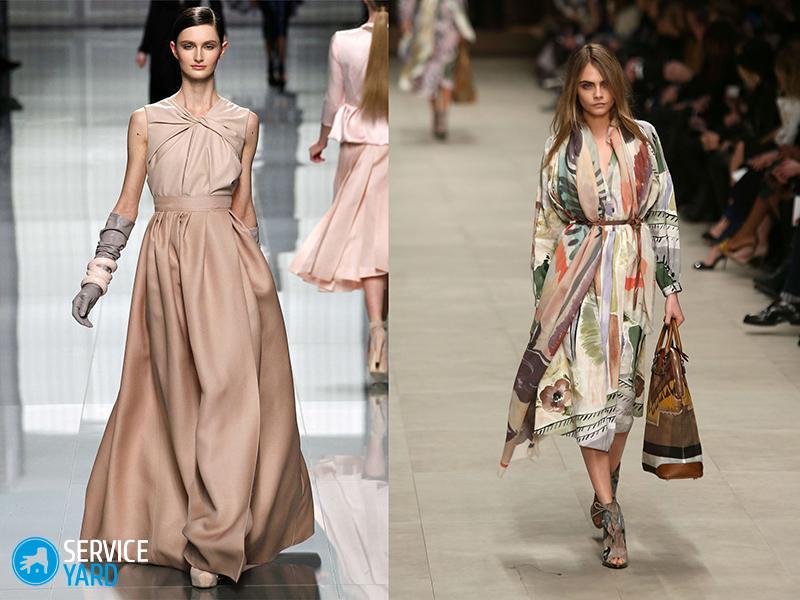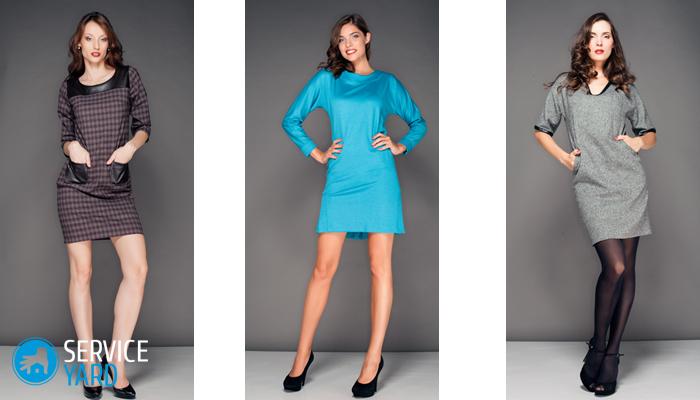What fabric to sew a summer dress from?

A dress has long been an optional item in a girl’s wardrobe. Many are trying to find an option that would suit both the feast and the world. It is especially difficult to understand what fabric to sew a summer dress from, because a number of specific difficult requirements are put forward to it. Such an outfit should let the skin breathe, be easy to care for and look beautiful. Consider what materials to give preference to all the existing diversity in stores.
to contents ↑Natural fabrics for summer dresses: which are better?
It is natural material that has the best hygienic properties, but they also have drawbacks. We consider separately the features of each type of natural fabric for a summer dress.
Cotton
Cotton is widely used for sewing beach or walking dresses, as well as for office clothes. This is the most familiar and common material for summer dresses.
Depending on the density of the cotton fabric, several types of fabric are distinguished:
- chintz;
- satin;
- calico;
- denim
- batiste;
- flannel.
Advantages of cotton clothes:
- low price;
- does not cause allergies;
- it is not hot in the summer;
- has high hygroscopicity;
- easy care.
The disadvantages of cotton dresses:
- at high temperature, the wash may fade or shrink;
- burn out in the sun;
- wears out quickly enough.
Important! Over-dried cotton clothes are very difficult to iron out. It is better to remove such dresses a little damp.
Linen
If you are still thinking about what natural fabric to sew a summer dress from, pay attention to linen. This is the second most popular material for outfits for a hot time. Such a canvas has long been woven from stems and leaves. Modern dressing of flax is a rather laborious business, therefore the cost of such a fabric is quite high.
Important! Linen cloth has a fairly dense structure. This allows you to sew from one fabric not only a dress, but also a jacket, thus forming a set that is suitable for a hot day and a cool evening.
Advantages of clothes made from natural linen:
- long service life;
- it is absolutely not hot in it;
- quickly absorbs moisture and also quickly evaporates it;
- tolerates bleaching and boiling;
- does not cause allergies;
- pleasing to the body.
Disadvantages of flax outfits:
- crumple very much;
- difficult to smooth out.
Important! When choosing a dress made of flax, pay particular attention to the amount of stock of material at the seams. The edges of such a fabric crumble very strongly, so if it is stitched almost end-to-end, then over time the seam can simply go apart.
Silk
This is one of the most expensive and luxurious materials, which is perfect for an evening outfit. The most appreciated Japanese silk, a little less - European and Chinese.
Important! Silk fabric has a very high density. Quality fabric has 130-280 weaves of threads per square centimeter. The higher this indicator, the longer the silk will last.
Advantages of silk outfits:
- chic appearance;
- natural shine;
- high strength;
- Do not heat up in hot weather;
- perfectly absorb moisture;
- not electrified.
The disadvantages of a dress made of silk:
- may shed during washing;
- requires very careful care;
- from splashing water, for example, when ironing, ugly stains may occur;
- absolutely does not stretch.
Important! Whether your silk dress will wrinkle depends very much on the type of thread - whether it is twisted or not, the production technology and the density of the fabric. It is very simple to solve this question in relation to a specific outfit - hold a little fabric in your fist and look at the result.
Chiffon
What material is best to sew a summer air dress from? For this venture, chiffon is ideal. It is this material that allows you to create romantic tender feminine outfits.
Initially, chiffon was made only of silk, which, of course, was reflected in the cost. Now, to create a chiffon fabric, different raw materials are used:
- natural - silk or cotton;
- artificial fiber - viscose;
- synthetic raw materials - polyamide and polyester.
Advantages of chiffon as a material for the summer:
- pleasant to the touch;
- perfectly breathable;
- does not fade;
- huge selection of colors;
- perfectly drapes and allows you to create beautiful folds and layered images, synthetic chiffon is especially good for this.
Important! Cotton chiffon is easy to sew, and also to wash and iron. But the silk-based material is very strewed, and only professionals can cope with it.
Disadvantages of chiffon:
- quite whimsical to care for;
- low wear resistance;
- fragile canvas.
Important! Important tips for caring for a chiffon dress:
- Silk-based products are best cleaned.
- Viscose chiffon is the most fragile material. It can be washed at home by hand, but you can’t categorically twist it. The maximum that you can afford - squeeze a towel.
- After washing, the dress must be dried on the shoulders or unfolded.
- All chiffon dresses must be ironed from the wrong side through wet gauze with an iron in the “silk” mode.
Atlas
This beautiful shiny material is appropriate at any time of the year. Perfect for both business attire and evening wear.
Important! Atlas, like chiffon, used to be made only of silk. Now it is made from cotton, acetate, polyester and other synthetic fibers.
Advantages of the atlas:
- lasting;
- fits the figure well;
- Suitable for sheath dresses;
- beautiful appearance;
- hygroscopic;
- opaque.
The disadvantages of dresses from satin:
- heavy compared to other summer fabrics;
- may “sit down” when washing in hot water;
- rough edges roll in very much;
- often stains after washing;
- it can be hot in a particularly hot season.
to contents ↑Important! To preserve the shiny surface of the satin fabric, you need to wash such products only by hand.
Artificial and synthetic fabrics for summer dresses
You can also choose synthetic fabrics for summer dresses. Which is better - artificial or natural - is up to you. But such dresses have their advantages.
Viscose
By its properties, viscose resembles cotton. It is also obtained from natural raw materials - wood pulp, but chemically.
Advantages of viscose as a material for a summer dress:
- soft;
- hygroscopic;
- good air permeability;
- dries quickly;
- not electrified;
- gently wraps around the figure.
- perfectly draped.
Disadvantages of viscose:
- wears out quickly;
- being wet becomes very fragile;
- may fade in the sun;
- hesitates;
- can stretch.
Important! A clean viscose cloth is a rather problematic material. But the canvas with small synthetic additives retains all its original advantages, but at the same time its disadvantages are significantly reduced.
Polyester
Polyester is a 100% synthetic fabric. The composition of such material can often be determined even by eye. But synthetics are not always - it’s bad, it also has advantages. For example, beautiful artificial silk and satin are made from polyester.
Advantages of polyester fabric:
- wear resistant;
- does not fade;
- dries quickly;
- easy care;
- resistant to damage and pollution;
- does not need special ironing;
- low cost.
Disadvantages of polyester:
- poorly breathable;
- may cause allergic reactions;
- does not absorb sweat;
- hard to touch.
Important! Polyester is very easy to burn with an iron, so use only the lowest temperatures.
Mixed fabrics
Nowadays it is rarely possible to find “clean” fabrics, the most common are a mixture of natural fibers and synthetic. 5-20% polyester or elastane is usually added to a natural canvas. Thanks to this partnership, natural fabrics receive only advantages:
- wrinkle less;
- become more durable;
- are reaching out.
to contents ↑Important! A sheath dress made of natural fabric will more advantageously sit on the figure and not hamper movement if a little elastane is added to the material.
Additional options when choosing fabric for a dress
When thinking about which fabrics for summer dresses are better, one should not lose sight of other parameters of the canvas, namely the pattern, density and texture.
Coloring and decor:
- Plain dresses are appropriate in any wardrobe. A simple cut product can easily be added with decorations or a hat, and turned into an evening or romantic outfit.
- The large, bright pattern is eye-catching, but it can also emphasize the flaws of the figure.
- Simple cut models will look beautiful with embroidery, beads or sequins.
Important! Dresses made of shiny fabrics, even natural silk or satin, can add visual volume to your figure.
Fabric density:
- The more complicated the style of the dress, the thinner the fabric should be. Chiffon, silk, viscose, crepe de chine are an excellent choice for a dress with drapery.
- Thin translucent fabrics are suitable for multilayer cocktail or evening dresses.
- A denser opaque material will help hide the flaws of the figure. Also, clothes for office are sewed from such a cloth.
- For a sheath dress, it is advisable to choose an elastic fabric that is not very stretched and is able to return to its previous state.
Stock footage
Now you know from what fabric you can sew a summer dress. The final choice, as always, is only yours. We hope you managed to find the perfect option - both in terms of the practicality of the material, and its comfort in wearing, and beauty.
- How to choose a vacuum cleaner taking into account the characteristics of the house and coatings?
- What to look for when choosing a water delivery
- How to quickly create comfort at home - tips for housewives
- How to choose the perfect TV - useful tips
- What to look for when choosing blinds
- What should be running shoes?
- What useful things can you buy in a hardware store
- Iphone 11 pro max review
- Than iPhone is better than Android smartphones



